Neo-Nazi marches in Dresden
In the 21st century, Dresden has been the site of some of the biggest gatherings of Nazis in post-War Germany. The annual right-wing marches in the beginning of February peaked in 2007 and in 2009 with about 6,500 participants.[1] With the marches a broad coalition of right-wing groups, old and new Nazis declared to remember the bombing of Dresden by Allied Forces at the end of World War II on the weekend after the anniversary of the bombings on February 13, 1945.

In contrast to other cities in Germany resistance against the marches from civil society and left-wing groups had been relatively weak for years. With the emergence of the Dresden Nazifrei alliance (Dresden without Nazis), the Nazi march was blocked from marching for the first time in 2010 by thousands of demonstrators, again in 2011 and prevented entirely in 2012.
Political context: A conservative state and city
While part of East Germany, Dresden was in the so-called "valley of the clueless" (Tal der Ahnungslosen), with its citizens out of the reach of the Western radio and television that citizens elsewhere in the East were able to listen to illegally. Dresden continued to be different after the German reunification; while most states in eastern Germany have been governed by varying coalitions, often involving the former SED, renamed Party of Democratic Socialism, Saxony was governed by the conservative Christian Democratic Union (CDU).
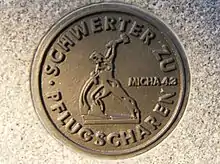

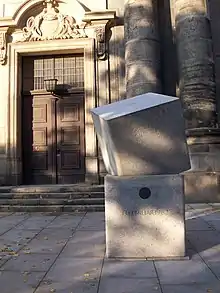
Commemoration of February 13, 1945
The Commemoration of February 13, 1945 reminds the Bombing of Dresden in World War II, which killed up to 25,000 citizens. These traumatic events led to a culture of remembrance with annual commemorative events. Regular political commemorative events took place in Dresden since 1946, earlier than in other German cities. The focus of these events changed several times and there have always been different focuses. But since 1946 the bells of all Dresden churches have been ringing on February 13 at 9:50 p.m.
Nazi Germany
Immediately after the destruction of Dresden, these attacks were misused for propaganda purposes by the Reich Ministry for Public Enlightenment and Propaganda and Joseph Goebbels.
Soviet occupation zone 1946 to 1949
The Soviet Military Administration emphasized a "deliberately provoked destruction of Dresden by the fascist criminals", to which "the political weakness of the German people" was partly to blame. The memorial should not have the character of mourning.
State Commemoration in East Germany 1949 to 1989
Later on the commemoration was largely taken over by the churches - traditionally the bells of all Dresden churches have been ringing on February 13 at 9:50 p.m.
Since 1955, the bombing of Dresden was used for GDR propaganda. The German-American John H. Noble, the former co-owner of the Kamera-Werkstätten Charles A. Noble and survivor of the Soviet gulag system, was released in 1955. Noble then wrote books about his experiences as a prisoner in Siberia.[2] In order to damage Noble's reputation, the former Saxon Prime Minister Max Seydewitz invented the Noble legend, telling that Noble directed the Allied air fleets with a transmitter placed in his private Villa San Remo in Dresden.[3]
During the Cold War, especially from the 1960s onwards, the blame was increasingly shifted to the Western allies, whose bombings were not aimed at military targets and had no strategic significance for the end of the war.
Opposition in East Germany since 1981
The state commemoration of the destruction of Dresden was criticized by the opposition, the civil rights movement, the peace movement and the churches in the GDR, since it took insufficient account of the German guilt.
In 1981 young people from the church peace movement in the GDR began a commemoration independent of state interests. From September 1981 they distributed the "Aufruf zum 13. Februar 1982" on illegal leaflets.[4] They wanted to carry out a symbolic candlelight action in front of the ruins of the Frauenkirche to protest against the increasing militarization of society.[5] This was stopped by the Stasi. The Evangelical-Lutheran Church of Saxony offered to organize a peace forum in the Kreuzkirche as a compromise. Finally the action was carried out in the Kreuzkirche. The Peace Forum on February 13 in 1982 with about 5000 participants became a highlight of the peace movement Swords to Plowshares[6] which was a precursor of the Peaceful Revolution.
The memorial Steine des Anstoßes ("Stones of Incentive") in front of the southern portal of the Kreuzkirche was built in 2010. It reminds of the Peace Forum in 1982. Since the Peaceful Revolution in 1989, the city representatives of Dresden have dealt more intensively with their past, especially during the anniversaries of the bombing of Dresden.
State Commemoration in Reunited Germany since 1991
Every year until 2015, the official ceremony to commemorate the air raids on Dresden took place in the morning of February 13. The location was the Heidefriedhof cemetery (de), were most of the victims are buried.
While right-wing extremists and neo-Nazis had been denied participation in the official wreath-laying ceremonies at the cemetery memorial for some time and could only unfold their actions after the official ceremony had ended, the NPD was also entitled to participate (2005–2014) in the official protocol with its entry into the Saxon State Parliament.
From 1999 to 2009: The emergence of the Neo-nazi demonstration
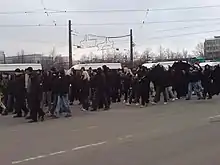

On February 13, 1990, the British Holocaust denier David Irving found around 500 consenting participants at a lecture in Dresden. His description of the air strikes as an Allied genocide gave a boost to neo-Nazis in the GDR, which officially never existed.
After the German reunification of East Germany and West Germany, and especially from 1992 onwards, more and more right-wing extremists used the annual commemoration for their propaganda.
In the mid-1990s small groups of neo-Nazis first mingled with Dresdenites of other political backgrounds that remembered the event at the site of the former Dresden Frauenkirche, which was destroyed during the bombing.
In 1999 about 150 neo-Nazis held their first own manifestation to remember the bombing of Dresden. In 2000 the Junge Landsmannschaft Ostdeutschland (JLO, "Youth Corps of Eastern Germany") organized its own nightly "funeral march" for the first time. In the next years the group organized the "mourning march" together with the neo-Nazi party National Democratic Party of Germany (Nationaldemokratische Partei Deutschlands (NPD)) and the Freie Kräfte (Free Forces), groups of neo-Nazi activists that are not party members. From 2001 to 2004, the number of participants in this event rose from 750 to about 2100, on February 13, 2005. Around 6,500 right-wing extremists demonstrated, and on February 13, 2007, about 1,500 people participated in the "Funeral March".[7]
In 2007 neo-Nazis from the Freie Kräfte criticized the remembering as ritualized and hollow and organized their own regionally planned and mobilized demonstration in Dresden, by 2010 this had grown to a week of action in which Nazis handed out leaflets and did little agit-prop actions. Thus in the following years Dresden had one small demonstration on the evening of 13 February or a day before organized by the Freie Kräfte and a big demonstration organized by the JLO on 13 February or the next Saturday or Sunday if 13 February was not on a weekend.[8]
Between 2000 and 2009 the "mourning march" grew bigger and bigger to become Europe's biggest Nazi demonstration.[9] By 2009 the participation had grown to peak with nearly 7,000. Delegations from far-right wing groups and parties from all over Europe attended. One particular reason for the growth in attendance was that other big Nazi demonstrations like those in Halbe and Wunsiedel were successfully blocked by anti-fascist protesters or forbidden by the authorities.[10]
The annual marches in Dresden had grown to an important event for the Nazi scene in Germany. On this day the numerous divisions in the scene and its problems were forgotten and the scene could see itself as powerful. Through commemorating those who died in the 1945 bombing of Dresden, a positive reference to National Socialism could be established to strengthen the own Nazi identity.[11]
Left wing protest against neo-Nazis in Dresden and reluctant politicians
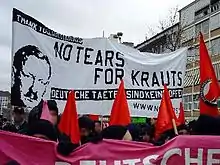
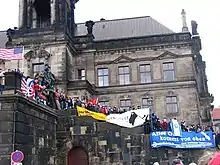
On the other hand, there were some initiatives against neo-Nazis, which found little resonance, because they were mostly initiated by left-wing extremists, like the "Anti-Germans", anti-imperialist and the Antifaschistische Aktion. Those initiatives were about bashing Nazis and showed little understanding for the victims of the air raids. They had slogans like "No tears for krauts" and "Bomber Harris, do it again" which sought to interrupt and to criticize the commemorating of the bombing, not only the Neo-Nazi marches, but also the state commemoration on the Heidefriedhof. This isolated the protest of the "Anti-Germans" and made it impossible for moderate citizens to participate. Most national anti-fascist groups as well as the ordinary Dresdenites could not be mobilized with this provocative tactic. The most notable act was a blockade of several hundred demonstrators, on the Carola Bridge in 2006, causing the Nazi march to change its route. Most of the time, however, the Nazis could march without much protest. Most of the time the protest was too little to influence the Nazi demonstration significantly, or prevent it.
The left wing protest was not endorsed by the Christian Democrats, the dominating political party in Dresden and Saxony at the time. Thus the ruling party seemed to tolerate the increase of right-wing extremist symbolism.[12] They tended to ignore the Nazis and instead opted for a silent commemorating of the victims of the bombings. Protest against the Nazis was seen as an intrusion, as an unwanted annoyance and political extremism on a day meant to belong to remembering the victims of the bombings.
The neo-Nazis did not find an official counterpart in Dresden until 2001. Then Ingolf Roßberg (FDP) became Lord Mayor. He invited clubs and associations for the first time to take coordinated action against right-wing extremist public events for the following year, and he supported the White Rose campaign. In addition, he appointed a commission of historians to determine the actual number of victims of the air raids on Dresden, and he also encouraged civic engagement through official action.
However, this was hindered by the Saxon CDU and Dresden citizens. According to a government statement by Kurt Biedenkopf before the Saxon state parliament, the Saxons are immune to right-wing extremism. This turned out to be a terrible misjudgment that continued to have an impact well into the 2010s. It gave a boost to right-wing extremist tendencies and blocked civic engagement against neo-Nazis.
The official commemoration ceremony consisted of the laying down of wreaths on a monument at Dresdens Heidefriedhof cemetery where most of the victims of the bombings are buried. For several years this event in which all political parties of the city and its religious congregations participated was attended by members and supporters of the neo-Nazi party NPD.[13]
Counter protest (2009)
In 2008 both anti-fascist groups that operated nationally and left-of-center parties, concluded that the annual Nazi march in Dresden was no longer a regional issue, but had way outgrown this limited importance by becoming the biggest gathering of Nazis in Germany. Thus, both groups organized protest against the Nazi marches in Dresden nationally. The first did so with the formation of national coalition of antifascist groups. No Pasaran, an antifascist slogan that originated during the Spanish Civil War, was its program and name. "This year we have federated as a preparatory alliance to approach the issues of Feb, 13th in a new way," announced one antifascist group of the alliance.[14] It also sought to distance itself from the protest-repertoires of the "Antideutschen" by proclaiming "We won't stand for the cheap celebrating of war dead". Instead it aimed to organize a "big antifa demo organized together with antifascist organizations from all over Germany on February 14th 2009".[15]
Left-of-center parties including the Green Party, the Social Democrats and the Left Party, together with their youth organizations, the German Associations of Unions (DGB), the Protestant church, the Jewish Congregation of Dresden and several liberal foundations formed the alliance Geh Denken (Go and Think/Commemorate). It sought to set a "Clear STOP to Right-wing extremism" in a "peaceful and non-violent way".[16] It collected 200 initial signatories for its call to action; 10,000 people signed the call during the campaign.[17] Absent from this coalition were the Christian Democrats that run the city.
On 14 February No Pasaran organized a demonstration said to comprise 2,500 (according to the police) and 4,000 peaceful antifascists (according to the organizers) from across Germany attending in the inner-city of Dresden. The demonstration was dominated and led by a large black bloc and was closely monitored and accompanied by the police. At the end of its official route the demonstration tried unsuccessfully to break through police lines to unite with the demonstrations of the Geh Denken alliance. With the use of bats and pepper spray the police prevented any attempts of groups of antifascists to get close to the gathering point of the Nazis after the dispersal of the demonstration.[18]
Not far away 12,000 people came together when three demonstrations organized by Geh Denken joined at the historic Schloßplatz to hear speeches and performances by several artists. Among the protesters were Franz Münthefering (Chairman, Social Democrats), Claudia Roth (Chairwoman, The Greens), Gregor Gysi (Chairman, The Left) and Michael Sommer (head of the German Associations of Unions). It was the start of the super election year of 2009 with several federal and the national elections coming, thus the mentioned politicians wanted to show their opposition to neo-Nazis.[19]
In evaluations of the day on group of the No Pasaran network spoke of a "moldy after taste" despite a "successful mobilization".[20] The alliance Geh Denken spoke of an experience that was "simultaneously successful and bitter" and that the police had "suppressed protest along the Nazi-route".[21] Both alliances acknowledged that the Nazi-march had not been stopped by their efforts. As a consequence the Geh denken alliance dissolved afterwards.
At the end of the day a group of 40 neo-Nazis attacked antifascist demonstrators traveling home from the counter-demonstration on a highway stop. One protester, a 42-year-old union member, was severely wounded and brought to a hospital with a skull fracture after being kicked repeatedly by neo-Nazis travelling home from their demonstration in Dresden.[22] The alliance Geh Denken reported "at least" four assaults by neo-Nazis that day on counter demonstrators.[23]
Dresden Nazifrei (2009–2012)
The failed intervention against the Nazi-march in February 2009 provided the setting for the Dresden Nazifrei alliance in fall of 2009. It was announced on an "action conference" organized by No Pasaran in Dresden.[24] The conference announced a public call to block the Nazi march. It said: "We will use the tactic of mass blockades in which everybody can participate to prevent the Nazi-march" and it called for the creation of a "framework to plan and coordinate the necessary actions".[25] This framework was created with the official announcement of the creation of the alliance Dresden Nazifrei (Dresden without Nazis) in the first week of December 2009. Part of the alliance of more than 50 groups were the antifascist groups of the No Pasaran alliance, local citizen groups, liberal parties like the Left, the Greens and parts of the Social democrats, different unions and the youth organizations of the parties and unions. In a press release Dresden Nazifrei declared: "Our blockades are a form of action in which people experienced and those inexperienced in protest, young and old people, can participate simultaneously".[26]
During the protests on February 19, 2011 a group of 200 neonazis attacked an alternative housing project, while police was bystanding.[27][28]
March blocked for the first time (2010)
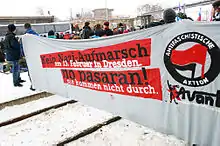
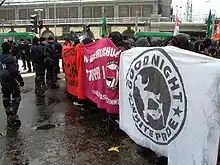
In the weeks before 19 February police units searched office of member-organizations of Dresden Nazifrei that distributed mobilization posters to confiscate them, it shut down the German homepage of Dresden Nazifrei (which moved to a .com address), and it called private travel companies that provided buses for demonstrators of the alliance to cancel the buses. The moves by the Saxon authorities backfired, it sparked the mobilization. More than 2,000 people and more than 600 organizations and groups signed the call of Dresden Nazifrei to block the march of the Nazis.
2010 marked the 65th anniversary of the bombings and with the conflicts of 2009 the city's authorities were under pressure to react to the threat of another big Nazi demonstration without any protest. The city government set up a working group entitled Arbeitsgruppe 13. Februar (Working group 13 February). It included all big parties, congregations and organizations from civil society.[29] For 13 February it mobilized the citizens of Dresden to form a human chain around the historic center of the city that was meant to "remember in depth and forcefully the horrible events in 1945 and to protect the city against violence and extremism", according to Dresden's mayor Helma Orosz.[30]
Meanwhile, Dresden Nazifrei mobilized its followers for the announced mass-blockades. On the early morning of 13 February more than 100 buses from more than 50 cities in Germany, Austria and Switzerland arrived in several large convoys in Dresden. More than 30 buses traveled together in a convoy from Berlin.[31] The buses were used to bring the demonstrators as close as possible to the neo-Nazi gathering points. After getting out of the buses the demonstrators formed demonstrations that split into smaller groups when they encountered police lines to trickle through it or circumnavigate it, while heading to several blockade points, that had been announced earlier that day by Dresden Nazifrei. About 12,000 peaceful protesters blocked the streets around the gathering point of the Nazis at the Neustadt train station with four large blockades and several smaller blockades.
While the police forces dropped their efforts to evict the bigger blockades after a short time, some smaller blockades were evicted with the use of batons and pepper-spray. During the day, several confrontations between autonomous antifascists and the police who had deployed 5.700 officers in the whole city occurred.[32]
Close to the blockades, groups of antifascists confronted little groups of Nazis trying to get to their gathering point. More than 1,000 Nazis marched from the highway through suburbs through Dresden's alternative "Hechtviertel" neighborhood, attacking an alternative youth center on their way to their gathering point at the Neustadt train station. More than 500 Nazis had gathered there to march. Due to the blockades the police called off the march in the afternoon. The police said it could not guarantee a safe and undisturbed march.[33]
Meanwhile, about 15,000 Dresdenites participated in the human chain that was closed around the historic city for several minutes on the other side of the river in Dresden's historic center.[34] "The human chain does not go beyond symbolic protest", criticized a spokesperson from Dresden Nazifrei. The alliance highlighted that the human organized by the city took place "far away from the Nazi march" and was "not even at the same time".[35] The mayor of Dresden Helma Orosz, however, claimed later that the human chain had prevented the Nazi march.[36]
At the end of the day the legal team of Dresden Nazifrei reported 24 persons arrested. The demonstration medical team reported the treatment of 100 people.[37] In the evening 3,000 people who participated in the blockades celebrated the blockade of the Nazi march with a spontaneous demonstration. Meanwhile, disappointed neo-Nazis traveling home from the prevented demonstration rioted in the nearby towns of Pirna and Gera attacking an office of the Social Democratic Party.[38]
Dresden Nazifrei declared "A great success in the history of antifascist mobilizations" and "a bitter defeat for the Nazis in their 'fight for the street'" in a statement at the end of the day.[39] In the following days and weeks, the German Nazi-scene debated how to cope with blockades in the future. A leading Nazi-activist from Hamburg urged for a change in tactics proposing a concept of organizing several marches, a star march.[40]
March blocked again(2011)
.jpg.webp)
A few weeks before a local court had ruled in favor of the neo-Nazis that the police force had done too little effort to guarantee the Nazis their constitutionally provided right to assemble and demonstrate.[41] The police announced a strict strategy of separation. In this tenuous atmosphere Dresden Nazifrei insisted on their plan to blockade. It mobilized mostly against the big national Nazi-march which was scheduled for the week after 13 February. While Dresden Nazifrei had internally debated how to intervene against the prevailing myth of Dresden in 2010, it organized a tour guided by historians to the places of former national-socialist leaders and institutions that worked in Dresden on the morning of 13 February 2011. The tour was forbidden by Saxonian authorities, and about 500 people participated in a protest against the ban.[42] Later that day 1,300 Nazis from Saxony marched in a demonstration organized by the regional Nazi-scene and the Freie Kräfte with torches largely undisturbed through a suburb of Dresden. About 3,000 people participated without success in efforts to block the regionally mobilized Nazi-march.[43]
On 19 February Dresden Nazifrei and No Pasaran could increase their mobilization compared to 2010. On the morning of 19 February more than 260 buses with thousands of protesters from across Germany and neighboring countries drove to Dresden.[44] They were stopped by police forces when leaving the highway and walked several miles in different groups and demonstrations to get to the blockade points announced by Dresden Nazifrei and to encircle the Nazis at their gathering point. On several occasions big groups of antifascists circumnavigated or broke through police lines.[45]
The police used pepper-spray, batons, dogs, pepper-ball guns, helicopters, a drone, and water cannons at temperatures of about zero degrees Celsius to enforce the announced strict spatial separation between Nazis and anti-fascist protesters. However, the 4,500 police officers could not prevent that about 20,000 antifascists entering the area where the Nazi-marches should have taken place. Around noon the police increasingly lost control over the area where anti-fascists set up several peaceful blockades.[46] On several occasions rioting and heavy street-fighting erupted between autonomous antifascists and the police,[47] even if "most protests against the Nazis were peaceful".[48] Dresden Nazifrei criticized that the police attacked protesters regardless if they protested peacefully or not. "Apparently the police wants to maul the Nazi-march through against all odds," commented a spokesperson of the alliance at noon.[49] In the afternoon when it was obvious that the strategy of separation had failed the Nazi-march was canceled by the police.
The strategy of the Nazis failed. To counter the announced antifascist blockades they had announced to do three marches that would come together at their end. With about 2,000 Nazis who were in the city on that day, the scene was able to mobilize fewer followers than in the year before. Due to the blockades most of them did not even reach their gathering points. Only about 50 made it to one gathering point at Nürnberger Platz, and about 400 and 500 assembled near the main train station. A group of about 100 Nazis marched from the suburb of Dresden to the Plauen neighborhood where they were stopped by the police. A big group of Nazis trying to get to their gathering point attacked the left housing project Praxis in the Löbtau neighborhood.[50]
At the end of the day the Medical Team reported the treatment of more than 200 persons who were injured by pepper-spray. More than 150 protesters were injured; fractured bones, bruises and lacerations were treated.[51] Dresden Nazufrei commented "A successful day with an aftertaste" which concluded that the aggressive policing had caused the escalation at several sites into rioting on that day.[52]
The police reported 82 hurt policemen, and the opening of 60 penal charges against protesters for rioting, assault and property damage and against more than 200 people for violations against the law of assembly. The police bemoaned a new quality of violence and set up a special commission called Soko 19th February to investigate what happened on that day.[53]
"Dresden stands up with all force against Nazis" commented the German television N24, and the Dresden-based newspaper Morgenpost wrote "Blockades set Nazis on checkmate".[54]
In an analysis Dresden Nazifrei concluded: "While 2010 the forces of order allowed the declaration of a state of emergency because of the protest thus cooperating with us, this year we had to fight through the blockade of the Nazi-march against the city administration, courts and the police who wanted to let the Nazis march at all costs".[55] The Nazi news page Mupinfo concluded "Dresden 2011 has ended with a defeat" afterwards.[56]
Nazi march prevented entirely (2012)
On 13 February, a Monday, between 1,600 and 2,000 Nazis participated in the regionally attended Nazi-march.[57] About 6,000 demonstrators participated in protests organized by Dresden Nazifrei and set up three blockades on the route of the Nazis. The 5,800 policemen deployed by the city on that day engaged in a strategy of de-escalation and did not try to evict the blockades. The route of the Nazis was shortened significantly due to the protests and degraded to a "tour around the block". "We ridicule our-self with this," Nazis commented later on the internet. During the Nazi-march a group of Nazis refused to continue their march after they had learned that their march was shortened. The newspaper "Die Tageszeitung" commented "No violence, no riots, frustrated Nazis, lucky antifascists" later that day.[58]
On the same day 13,000 people attended the human chain organized by the city. Later some people from the human chain joined the blockade and protest actions organized by Dresden Nazifrei'. According to Dresden's mayor Dirk Hilbert (FDP), the human chain was a "clear sign against national-socialism, racism and violence".[59]
This year the tour "On the traces of the National-Socialists" by historians of Dresden Nazifrei to criticize the "Myth of Dresden" was allowed and took place with 2,500 people attending.[60]
In the months before 19 February the mobilization of the JLO to the national Nazi-demonstration was very weak. Weeks before the demonstrations rumors that the Nazi might call off their demonstration spread and became certainty when the Nazis dropped their demonstration. The Dresden Nazifrei and "No Pasaran" alliances nevertheless mobilized their supporters to blockade the march because the alliance feared the last-minute registration of a demonstration by another group.[61]
Instead Dresden Nazifreimobilized for a "big antifascist demonstration" to celebrate that the "big Nazi-march seems to be history" and to press their goal of an "anti-fascist consensus".[62] In what a local newspaper reported to be "one of the biggest antifascist demonstrations in post-war Germany", about 10,000 people demonstrated through Dresden to protest against "Nazis, historical revanchism and repression", as the front-banner read.[63] At the same time the city-controlled "Arbeitsgemeinschaft 13. Februar" organized a protest against the Nazis on the historical Schlossplatz square with the slogan "With Courage, Respect and Tolerance". 1,500 people attended.[64] This was the ruling Christian Democrats changing their position that protest against Nazis was necessary. This year the "Arbeitsgemeinschaft 13. Februar", although it did not support blockades, sought to organize protest "in optical and audible range" to the Nazi-march thus moving to a more active form of protest.[65]
Action consensus of "Dresden Nazifrei"
The action-consensus that guided the blockades, that was negotiated between the groups that made the alliance Dresden Nazifrei', was: "We engage in civil disobedience against the Nazi demonstration. We will not escalate conflicts. Our mass blockades consist of people. We are in solidarity with all those who share with us the goal of preventing the Nazi demonstration".[66]
The first sentence labels the action as one of civil disobedience, thereby seeking to legitimize it. The second sentence avoids the ideologically charged notion of "non-violence", a notion that the left-radical parts of the alliance would not have accepted, by announcing a less strong "non-escalation". At the same time its purpose is to make clear that the alliance will not attack the police. The third sentence further specifies the action of civil disobedience as consisting of people. This can be read as a strong hint towards the left-radical supporters of the alliance who – at other times – engaged in street-fighting and the setting up of barricades as material non-human blockades. The last sentence sought to prevent the separation into "bad" (autonomous, violent) and "good" (civil society, peaceful) protesters that were often and most notably put forward by conservative politicians and the German intelligence services. The last sentence, the solidarization with all people who protested against the Nazi-march also sought to establish Dresden Nazifrei as a project that presented all currents of the political left.
This consensus was not new. It was developed by the Campaign "Block G8" that had blocked roads around the site of the G8 summit in Heiligendamm, Germany in 2007 and further large actions of civil disobedience in Germany in recent years. Its aim was to make the action calculable both for people that wanted to participate, as well for the police. The alliance Dresden Nazifrei provided detailed information on the movements of Nazi groups and police units in the city and about the blockades and actions organized by the alliance via a Twitter-channel, a text-based mobile-phone ticker and a telephone hotline advising protesters.[67]
The alliance used public trainings of blockade techniques to generate both media attention that helped to spark the mobilization and to generate legitimacy for the alliances claim that the blockades were a legitimate action of civil disobedience. They sought to penetrate the public consciousness and to normalize actions of civil disobedience as part of the politically accepted repertoire of protest in a politically conservative city.[68] In 2012 73 percent - a majority of Dresdenites - supported the peaceful blockades of Nazi-marches as pollster have found. Only 18 percent said they disagreed with blockades while another 9 percent remained undetermined.[69]
Aftermath
.jpg.webp)
The actions of Dresden Nazifrei and the response of Saxonian police forces and the ruling conservatives which criminalized calls to block the Nazi-marches, prosecuted people who participated in blockades, stormed the media center of the alliance and prosecuted organizers as "members of a terrorist organization", the annulment of parliamentary immunity of Left Party parliament-members who participated in the protests and the surveillance of all mobile-phones who were present in the area of the protests of 19 February 2011 provoked a debate about what Wolfgang Thierse, head of the German parliament from the Social Democrats, famously called "Saxonian Democracy".[70] That term summarized the national perception of Saxony and Dresden as a state and city governed by authorities that acted in an aggressive and authoritarian way against the left and non-conservative civil society groups while ignoring Nazis on the other side and not discovering the right-wing terrorist cell of the "National-Socialist Underground" (NSU) that had operated from Saxonian territory in the last years.
Notes
- http://www.sz-online.de/nachrichten/artikel.asp?id=2281445
- Noble, Gulag Survivor, Dies at 84, Douglas Martin, The New York Times, Nov. 26, 2007
- Winfried Sträter (10 May 2006). "Wie man die Hölle überlebt: John Noble – ein Amerikaner in sowjetischen Lagern". Deutschlandradio Kultur.
- "Aufruf zum 13. Februar 1982 in Dresden", written by Annett Ebischbach, Torsten Schenk and Oliver Kloss, printedt by Elke Schanz and Heike Kerstan.
- Geschichte Mitteldeutschlands im Mitteldeutschen Rundfunk (mdr) am 2. Oktober 2012 with Johanna Kalex (initiator, then Annett Ebischbach), Elke Schanz (printer) und Oliver Kloss (initiator), minute 15:26 to 22:30.
- Das Ereignis wurde mit Bildmaterial in den Abendnachrichten westlicher Fernsehsender gemeldet, in Zeitungen und Zeitschriften – z. B. Spiegel, Heft 8 (1982) vom 22. Februar 1982: DDR: Fleißig Unterschriften. Die SED sorgt sich um eine neue Protestbewegung in der DDR: Junge Leute demonstrieren zu Tausenden gegen Rüstung und Militarismus. S. 28–31 – sowie zeitnah in Buchform dokumentiert: Klaus Ehring, Martin Dallwitz: Schwerter zu Pflugscharen. Friedensbewegung in der DDR, Reinbek bei Hamburg, Rowohlt, 1982, ISBN 3-499-15019-0; Wolfgang Büscher, Peter Wensierski, Klaus Wolschner, Reinhard Henkys (Hrsg.): Friedensbewegung in der DDR. Texte 1978–1982, Hattingen, Scandica, 1982, ISBN 3-88473-019-3, S. 265–281.
- "Rechtsextreme "Aktionswoche"". Blick nach Rechts. 8 February 2007. Retrieved 12 February 2014.
- Alexanda Anders, http://www.akweb.de/ak_s/ak568/Dresden_Speciale_2012.pdf
- http://www.sz-online.de/nachrichten/artikel.asp?id=2281445, for a complete chronicle see Alexa Anders in: http://www.akweb.de/ak_s/ak568/Dresden_Speciale_2012.pdf
- Alexanda Anders, http://www.akweb.de/ak_s/ak568/Dresden_Speciale_2012.pdf
- http://nopasaran.site36.net/aufruf-2/
- Dresden geht denken, Die Tageszeitung, 12. 2. 2012
- http://www.slideshare.net/lordofwinds/geh-denken-alliance
- http://dresden1302.noblogs.org/post/2008/10/25/welcome/
- http://dresden1302.noblogs.org/post/2008/10/25/welcome/#more-3
- http://www.geh-denken.de/joomla/2009/selbstverstaendnis.html, see as well: http://www.geh-denken.de/joomla/2009/international.html
- http://www.slideshare.net/lordofwinds/geh-denken-alliance
- http://www.spiegel.de/video/protest-gegen-nazi-gedenkmarsch-dresden-zeigt-flagge-video-51541.html
- http://www.geh-denken.de/joomla/2009/international.html
- http://www.akweb.de/ak_s/ak537/12.htm
- http://www.geh-denken.de/joomla/position.html, http://www.slideshare.net/lordofwinds/geh-denken-alliance
- See: http://www.bild.de/news/2009/dresden/treten-gewerkschafter-schaedel-ein-7405516.bild.html, http://www.sz-online.de/sachsen/buttolo-in-erklaerungsnot-opfer-geht-es-besser-2147923.html
- http://www.slideshare.net/lordofwinds/geh-denken-alliance
- http://dresden1302.noblogs.org/gallery/5061/aktionskonferenz.pdf
- http://dresden1302.noblogs.org/post/2009/11/11/aktionskonferenz-endet-mit-resolution/
- http://leipzig-seiten.de/index.php?option=com_content&task=view&id=7841&Itemid=96, http://www.sz-online.de/nachrichten/artikel.asp?id=2332904
- "Ich dachte, ich muss sterben" – Rechte überfallen Wohnprojekt in Dresden-Löbtau (″I thought, I have to die" – Rights assaulting housing project in Dresden Löbtau), September 9th, 2011
- https://blog.zeit.de/stoerungsmelder/2011/02/20/dresden-neonazis-griffen-alternatives-kulturzentrum-an_5740
- http://13februar.dresden.de/de/ag-13februar.php
- http://13februar.dresden.de/de/presse/pm_100113.php
- http://www.neues-deutschland.de/artikel/165121.eine-busreise-nach-sachsen.html
- Sächsische Zeitung 02/15/2010, http://dresden1302.noblogs.org/post/2010/02/15/sachsische-zeitung-wie-dresden-aufstand-und-sich-wehrte/, http://www.taz.de/1/archiv/digitaz/artikel/?ressort=sw&dig=2010%2F02%2F15%2Fa0001&cHash=8a8e0407e0
- http://www.sueddeutsche.de/politik/neonazi-demo-in-dresden-marsch-und-menschenkette-1.1059190, http://www.taz.de/1/archiv/digitaz/artikel/?ressort=sw&dig=2010%2F02%2F15%2Fa0001&cHash=8a8e0407e0
- Sächsische Zeitung 02/15/2010, http://dresden1302.noblogs.org/post/2010/02/15/sachsische-zeitung-wie-dresden-aufstand-und-sich-wehrte/, http://www.der-rechte-rand.de/wp-content/uploads/DRR_EXTRA_Dresden.pdf
- http://dresden-nazifrei.com/images/stories/Presse/Press_Release-Dresden-Nazi-Free-International_mobilization_against_Europes_biggest_nazi_march.pdf
- http://taz.de/Anti-Nazi-Protest-in-Dresden/!48413/
- http://dresden1302.noblogs.org/post/2010/02/19/schadensbericht-bilanz-der-angriffe-von-nazis-und-polizeiaktionen-f-r-linke-und-alternative-projekte/
- http://www.taz.de/1/archiv/digitaz/artikel/?ressort=sw&dig=2010%2F02%2F15%2Fa0001&cHash=8a8e0407e0, http://www.neues-deutschland.de/artikel/165121.eine-busreise-nach-sachsen.html
- http://www.dresden-nazifrei.com/index.php?option=com_content&view=article&id=73%3Arueckblick-2010&catid=40%3Ablockaden&Itemid=59&lang=de
- http://dresden1302.noblogs.org/post/2010/02/15/sachsische-zeitung-wie-dresden-aufstand-und-sich-wehrte/
- http://www.sueddeutsche.de/politik/neonazi-demo-in-dresden-marsch-und-menschenkette-1.1059190
- http://www.dnn-online.de/web/dnn/nachrichten/detail/-/specific/700-NR_DNN_20852
- http://www.der-rechte-rand.de/wp-content/uploads/DRR_EXTRA_Dresden.pdf
- http://www.der-rechte-rand.de/wp-content/uploads/DRR_EXTRA_Dresden.pdf
- https://www.youtube.com/watch?v=lBS4fvHx0GQ
- http://taz.de/!66211/; http://www.neues-deutschland.de/artikel/191395.nazis-frustriert-polizei-ueberfordert-antifa-happy.html
- http://www.spiegel.de/politik/deutschland/krawalle-dresden-wehrt-sich-mit-gewalt-gegen-neonazi-aufmarsch-a-746612.html, http://www.rp-online.de/politik/deutschland/tausende-demonstranten-verhindern-neonazi-aufmarsch-1.2127861
- Sächsische Zeitung 02/21/2011, Dieter Schütz, http://dresden-nazifrei.com/images/stories/Presse/Pressespiegel/Pressespiegel_vom_19._bis_21.02.2011.pdf
- http://www.dresden-nazifrei.com/images/stories/Presse/Pressemitteilung_des_Bndnisses_Nazifrei-Heftige_Proteste_gegen_Naziaufmarsch_in_Dresden.pdf
- http://taz.de/!66216/, http://taz.de/!66211/, http://www.neues-deutschland.de/artikel/191395.nazis-frustriert-polizei-ueberfordert-antifa-happy.html, https://www.youtube.com/watch?v=k6MxvHk9P4o
- http://www.dnn-online.de/web/dnn/nachrichten/detail/-/specific/700-NR_DNN_21436
- http://www.dnn-online.de/dresden/web/regional/politik/detail/-/specific/Erfolg-mit-Beigeschmack-Dresden-Nazifrei-ist-mit-Ergebnis-des-19-Februar-zufrieden-4184531992
- Sächsische Zeitung 02/21/2011, Alexander Schneider and Lars Rieschke, online http://dresden-nazifrei.com/images/stories/Presse/Pressespiegel/Pressespiegel_vom_19._bis_21.02.2011.pdf
- https://www.youtube.com/watch?v=yJfu3erB2Y4, see page 22f. in: http://www.dielinke-europa.eu/serveDocument.php?id=211.a87.pdf, for more press articles see http://www.dresden-nazifrei.com/index.php?option=com_content&view=article&id=182:pressespiegel-19-februar&catid=43&lang=de&Itemid=, or this documentation: www.dielinke-europa.eu/serveDocument.php?id=211.a87.pdf
- http://www.dresden-nazifrei.com/index.php?option=com_content&view=article&id=191%3Anazifrei-dresden-stellt-sich-quer-2011-die-auswertung&catid=1%3Aaktuelle-nachrichten&lang=de
- http://taz.de/!66216/
- Different estimates from the police and a newspaper: http://taz.de/Proteste-gegen-Nazi-Aufmarsch-in-Dresden/!87673/
- http://taz.de/Proteste-gegen-Nazi-Aufmarsch-in-Dresden/!87673/, http://taz.de/+-+-+-Ticker-Neonazi-Aufmarsch-Teil-II-+-+-+/!87579/, http://www.netz-gegen-nazis.de/artikel/wir-machen-uns-zum-gespoett-wenn-wir-das-als-erfolg-werten-1478
- http://taz.de/Proteste-gegen-Nazi-Aufmarsch-in-Dresden/!87673/
- http://taz.de/Proteste-gegen-Nazi-Aufmarsch-in-Dresden/!87673/
- http://www.dnn-online.de/dresden/web/regional/politik/detail/-/specific/Naziaufmaersche-in-Dresden-alles-konzentriert-sich-auf-den-13-Februar-405754138, http://dresden-nazifrei.com/index.php?option=com_content&view=article&id=311%3Aindymedia-interview-mit-dresden-nazifrei&catid=1%3Aaktuelle-nachrichten&Itemid=1&lang=en
- http://dresden-nazifrei.com/index.php?option=com_content&view=article&id=336%3Aaufruf-zum-182&catid=55%3A18-februar-2012
- There were more than 100,000 according to organizers, and 60,500 according to the police. http://www.addn.me/antifa/siamo-tutti-antifascisti/comment-page-1/
- http://www.dresden.de/de/02/035/01/2012/02/pm_067.php
- http://taz.de/Naziaufmarsch-in-Dresden/!80300/
- http://www.dresden-nazifrei.com/index.php?option=com_content&view=article&id=72:aktionskonsens&catid=43&lang=de&Itemid=
- See for instance this listing: http://dresden1302.noblogs.org/post/2010/02/04/hard-facts-alles-wichtige-zum-13-februar-2010-in-dresden/
- Only one of may blockade trainings and the surrounding controversy is covered here: http://www.dnn-online.de/dresden/web/regional/politik/detail/-/specific/CDU-und-FDP-kritisieren-Blockadetraining-von-Dresden-Nazifrei-Gruene-wollen-mittrainieren-4025966386
- http://www.dnn-online.de/dresden/web/regional/politik/detail/-/specific/DNN-Barometer-Mehrheit-der-Dresdner-befuerwortet-friedliche-Blockaden-von-Nazi-Demos-797623438
- http://dresden-nazifrei.com/images/stories/Presse/DresdenNazifrei_pressemappe_repression.pdf, for the quote of Thierse see: http://www.sz-online.de/nachrichten/polizeichef-zeigt-bundestagsvize-thierse-an-2415282.html